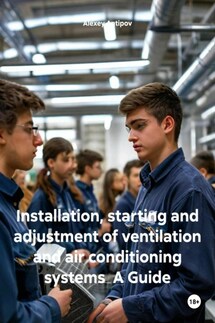Installation, starting and adjustment of ventilation and air conditioning systems A Guide - страница 7
Such a system, using a cross-flow recuperator and made in the form of a monoblock, is characterized by a high efficiency of heat recovery, reaching 70%, and provides at least a twofold reduction in operating costs for air heating due to heat recovery (Fig.7).
Fig.7. Supply and exhaust system with recovery
Heat recovery units are designed for the organization of supply and exhaust ventilation in comfortable air conditioning systems, i.e. they change the temperature and humidity of incoming fresh air taking into account the climatic conditions inside the serviced room.
The cross-flow plate regenerative heat exchanger is made of a heat-conducting material having the property of selective permeability with respect to water molecules (practically the membrane is impermeable with respect to molecules of other gases and substances). Due to this, the difference in the partial pressures of water vapor in the outdoor and exhaust air leads to the transfer of moisture from one stream to another. In the cold season, water molecules from the wetter exhaust air penetrate through the membrane into the outside air stream, humidifying it. In the warm season, water molecules from the wetter outdoor air penetrate into the exhaust air stream, preventing excessive humidification of the room.
3.5. Heaters
To heat the air in the supply ventilation units, heaters (air heaters) are used.
Fig.8. Water heater
High-temperature water or steam is used as a heat carrier for heaters. When the heating liquid is water, the heaters are marked as HW, when steam is marked as HS.
Heaters designed to work with a steam coolant are manufactured single – pass, with a water coolant-both single-pass and multi-pass. In single-pass heaters, the coolant passes through the entire bundle of tubes simultaneously from one collector to another, and in multi-pass collectors are separated by internal partitions that repeatedly change the direction of movement of the coolant, which increases the speed of water movement through the tubes and, as a consequence, increases the heat transfer of the heater. The connection of fittings in single-pass heaters is diagonal, and in multi-pass ones it is one-sided (Fig. 9).
Fig. 9. The flow diagram of the coolant in the heaters:
a – single–pass; b – multi-pass
Fins in the form of plates (plate heaters) or wound steel tape (spiral-wound heaters) are placed on the tubes to increase the contact area with the air passing through the heater. The outer fins are galvanized to reduce corrosion and better contact of the fins with the tubes. Fittings for the coolant are welded into the collectors, and to protect the fins from damage from the side, side shields are welded between the collectors. Flanges are used to connect the heater to adjacent elements of the ventilation system.
The arrangement of the tubes with the heating liquid can be consistent in the direction of air movement (corridor), staggered and offset along the corridor (most effectively). The tubes themselves can be either round or flat-oval in cross-section.
The best thermal engineering indicators have spiral-rolled bimetallic three- and four-row heaters for both steam (single-pass) and water (multi-pass) heater. The tubes for the heat carrier in these heaters are steel, the fins are rolled from aluminum.
Heaters are often grouped into several pieces, both with a parallel installation through the air, and with a sequential or combined one. If the heat carrier is steam, then the heaters are installed with a vertical arrangement of tubes and steam supply to the upper branch pipe; if the heat carrier is water, then the position of the tubes should be horizontal, which ensures the removal of air when filling the heaters with water and draining water from it when the system stops working.






